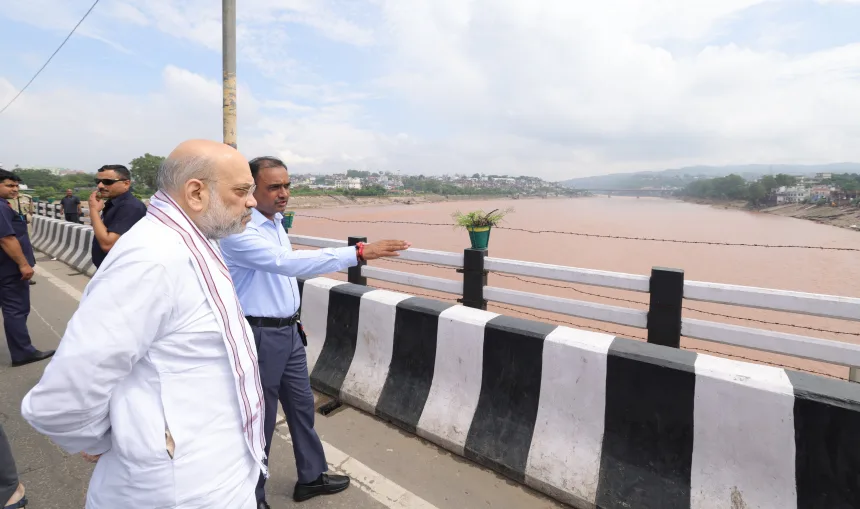Jammu, Sept 01: Union Home Minister and Minister of Cooperation Amit Shah on Monday conducted an extensive visit to flood, rain, and landslide-affected areas of Jammu division to assess the damage caused by the recent natural calamity. Shah undertook an on-ground inspection of critical sites, met displaced families, and chaired a high-level review meeting to streamline ongoing relief and rehabilitation efforts.
The Home minister arrived in Jammu on Sunday night to assess the flood situation and the relief efforts.
On Monday, Shah visited severely impacted locations including Manguchak village near the Jammu airport which is one of the worst-hit villages and interacted with the villagers and assured them of proper relief and rehabilitation, officials said.
He was accompanied by Lieutenant Governor Manoj Sinha, Chief Minister Omar Abdullah, Leader of Opposition in the Jammu and Kashmir Assembly Sunil Sharma and other senior BJP leaders, including the party’s Jammu and Kashmir unit chief, Sat Sharma.
“Today, visited Chak Mangu (Manguchak), a village affected by the recent floods in Jammu. Relief and rescue operations are being carried out in full swing by disaster response forces, along with providing assistance in medical care to the affected people. The Modi govt is committed to taking adequate measures for the rehabilitation of the affected people,” Shah said in a post on X.
Earlier, the home minister stopped on the Tawi bridge, near Bikram Chowk, and inspected the damage along the riverbanks. He was briefed by Jammu Divisional Commissioner Ramesh Kumar and other senior officers.
Expressing grief over the lives lost, he extended condolences to the bereaved families and assured that the Centre stands firmly with the people of Jammu and Kashmir in this hour of distress.
“In this hour of crisis, the Government of India, under the leadership of Prime Minister Narendra Modi, is fully committed to supporting the people of Jammu and Kashmir. Since day one, our teams have been engaged in comprehensive rescue and relief operations,” Shah said.
Following the field inspection, the Union Minister chaired a high-level meeting at Raj Bhavan with Lieutenant Governor Manoj Sinha, Chief Minister Omar Abdullah, senior officials from the Centre and UT administration and representatives of disaster management agencies. The review meeting focused on expediting relief distribution, rehabilitation of displaced persons, and enhancing disaster resilience in vulnerable areas.
Earlier, Shah conducted an aerial survey of the flood-hit areas across Jammu division. Shah acknowledged that timely alerts and coordinated response by the UT Disaster Management Authority (UTDMA), National Disaster Response Force (NDRF), Army, UTDRF, and other agencies significantly reduced potential damage. “Over 5,000 residents were evacuated to safer locations as a precautionary measure,” he noted.
According to official data, more than 130 people have lost their lives while 33 remain missing in the aftermath of cloudbursts, landslides, and flash floods that struck the districts of Kishtwar, Kathua, Reasi, and Ramban since August 14. Among the dead are 34 pilgrims who were killed in a landslide en route to the Mata Vaishno Devi shrine on August 26. The pilgrimage remained suspended for the seventh consecutive day on Monday due to inclement weather and safety concerns.
Currently, 17 NDRF teams, 23 Army columns, Indian Air Force helicopters, and personnel from the J&K Police and Central Armed Police Forces (CAPFs) are engaged in relief and rescue operations across affected areas.
Shah confirmed that ₹209 crore has already been released to the Union Territory under the State Disaster Response Fund (SDRF). Damage assessments of residential structures are underway for compensation purposes, and repair of roads and essential services has been fast-tracked. As of now, over 80% of the electricity supply has been restored, clean drinking water is being supplied, and health services are operational in most affected regions.
The Union Home Minister appreciated the efforts of the UT Government and rescue agencies, stating that the J&K administration carried out a swift and efficient rescue operation, which significantly mitigated the loss of life. “Health facilities and food arrangements have been made in relief camps by the UT government and the situation will return to normal very soon,” he added.
The Home Minister directed the Ministry of Home Affairs to deploy expert survey teams for a detailed assessment of the losses. Additional central assistance will be considered based on their findings. He also instructed departments, particularly health and water, to ensure uninterrupted service delivery. Medical units from the Army, CAPFs, and Air Force have been put on standby.
Emphasising the need for better disaster preparedness, Shah called for a critical review of Early Warning Apps (EWAs) and the Glacial Lake Outburst Flood (GLOF) early warning mechanisms. He stressed enhancing the accuracy and grassroots reach of such systems.
The Home Minister further directed the Meteorological Department and the National Disaster Management Authority (NDMA) to conduct a joint study using artificial intelligence and data analytics to understand the causes of cloudbursts. “Understanding atmospheric triggers and moisture patterns is essential for building a predictive warning system,” he said. Shah emphasized leveraging data analytics and AI to improve early warning systems, highlighting the need for a “zero-casualty approach.”
Shah also instructed the Food Corporation of India (FCI) to ensure an uninterrupted supply of ration, suggesting offline delivery mechanisms where digital connectivity remains compromised. He said that advanced survey teams from the Ministry of Home Affairs would assess the damage and that further assistance would be provided accordingly.
Reiterating the Centre’s full commitment to Jammu and Kashmir, Shah said: “Our priority remains the safety, well-being, and rehabilitation of the affected communities. Together, we will rebuild stronger and more resilient systems.”
He further announced that a meeting involving relevant Central Government departments, the Union Territory administration, and the Union Home Secretary would be held within 1-2 days to review ongoing relief and rehabilitation measures.
The Union Home Minister highlighted that Jammu and Kashmir is prone to natural calamities and that timely warnings by the Central Government and the UT Disaster Management Authority helped in minimising the loss of lives. “We had also informed everyone about the mobilization of the Army and the NDRF,” he said.
Assistance under the SDRF for damaged houses is currently being assessed and will be disbursed at the earliest. Repair and restoration work on damaged roads has begun, with traffic movement resuming on most routes, and relief supplies reaching affected areas.
More than 80% of electricity supply has been restored, clean drinking water is being provided, and health facilities are operational. Temporary restoration of critical infrastructure is underway on a war footing, with damages being assessed continuously.
On Sunday, the Union Government constituted Inter-Ministerial Central Teams (IMCTs) for Jammu & Kashmir, Himachal Pradesh, Uttarakhand, and Punjab to assess the damage caused by torrential rains, flash floods, cloudbursts, and landslides. The teams will conduct on-the-spot evaluations and monitor relief measures initiated by respective state governments.






